.gif)
Ralph Erskine (architect)
Encyclopedia
Ralph Erskine, CBRE, RFS, ARIBA (24 February 1914 – 16 March 2005) was an architect
and planner who lived and worked in Sweden
for most of his life.
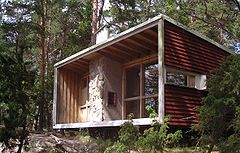
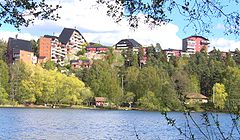
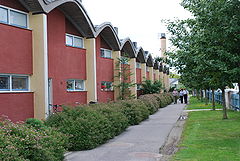
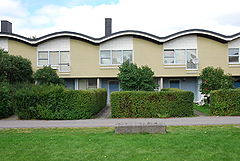
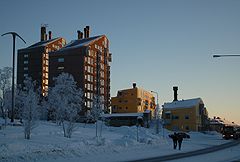
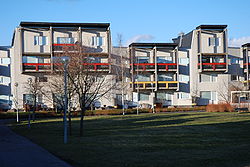 Erskine was born in 1914, in Monliaws, Northumberland
Erskine was born in 1914, in Monliaws, Northumberland
, but spent his childhood in Mill Hill in the London Borough of Barnet
(North London). His parents were socialists, adherents of the Fabian Society
, which promoted the idea of the evolution of Britain into a socialist state.
His Scottish father was a Presbyterian minister but his parents nonetheless sent him to the Quaker
school at Friends School Saffron Walden
(1925–1931), probably because of their socialist beliefs. There, he became committed to the Quaker ideals, which laid the foundation for his views on society, man's place in it, and on architecture.
, London under the direction of Thornton White. At the time, White’s curriculum required the study of classical architecture before students were free to follow their own ideas. One of his fellow students was Gordon Cullen
who would become a well-known architectural illustrator, urban designer and theorist. Cullen advocated the improvement of urban settlements through an understanding and analysis of their picturesque qualities. This approach was profoundly influential on Erskine, who insisted in his work that the context and landscaping of his buildings be carefully integrated.
under the leadership of Louis de Soissons. He studied town planning and this interest broadened his approach to architecture, in particular about how buildings related physically and socially to their setting.
Before the outbreak of World War II, Erskine traveled to Sweden. He was attracted there partly by his admiration for the work of the Functionalist
Swedish architects Gunnar Asplund
, Sven Markelius
and Sigurd Lewerentz
and partly by the country's adoption of the social welfare model
. In Sweden the political will was reflected in the national architecture and these two factors coincided with his own humanist beliefs. He would go on to make an important contribution to the architectural landscape of both his adopted country and to that of England.
In Sweden, England and Canada, he was responsible for the design of numerous innovative buildings reflecting his particular ideology. They include:
Erskine was best known in Great Britain for his Byker Wall
housing scheme in Newcastle upon Tyne and, The London Ark
, a commercial project in Hammersmith, London. However, it was his achievement in designing the winning scheme in a 1997 competition to develop the Millennium Community at Greenwich (Greenwich Millennium Village
), London that brought his work to widespread attention of his compatriot Britons. This recognition came late in a productive, long and important career.
said of Erskine that he “was one of the twentieth century’s greatest architects and in Newcastle's Byker estate he gave the city one of Europe's finest post Second World War new housing communities. His approach was so different from everything happening around that time as he put the focus on social regeneration and the interests of local people, rather than just bricks and mortar. He built Byker Wall Estate around the community. Local people were fully involved in the design and rather than clearing properties and moving people elsewhere, the community was able to remain together.”
Ralph Erskine founded his own company in Sweden in 1939. In 2000 he invited his long-time collaborator Johannes Tovatt into a partnership, naming the company Erskine Tovatt Arkitekter AB. It was Erskine's will that on his death his name be removed from the company. Therefore his legacy lives on in the company called Tovatt Architects and Planners in Drottningholm outside Stockholm.
In 1984, with his wife he established the Ruth and Ralph Erskine Nordic Foundation, endowed by proceeds from the Wolf Prize in Arts, which he was awarded that year. Beginning in 1988, the foundation has awarded a bi-annual prize of US$10,000 and a medal designed by Ralph Erskine, for any person, group or organization that “has contributed to the construction of buildings or community structures of innovative social, ecological and aesthetic character. The contribution must respect functional and economical aspects, and be to the advantage of the less privileged”.
In 1987 Erskine was awarded the RIBA
Royal Gold Medal
.
Architect
An architect is a person trained in the planning, design and oversight of the construction of buildings. To practice architecture means to offer or render services in connection with the design and construction of a building, or group of buildings and the space within the site surrounding the...
and planner who lived and worked in Sweden
Sweden
Sweden , officially the Kingdom of Sweden , is a Nordic country on the Scandinavian Peninsula in Northern Europe. Sweden borders with Norway and Finland and is connected to Denmark by a bridge-tunnel across the Öresund....
for most of his life.
Upbringing and influences






Northumberland
Northumberland is the northernmost ceremonial county and a unitary district in North East England. For Eurostat purposes Northumberland is a NUTS 3 region and is one of three boroughs or unitary districts that comprise the "Northumberland and Tyne and Wear" NUTS 2 region...
, but spent his childhood in Mill Hill in the London Borough of Barnet
London Borough of Barnet
The London Borough of Barnet is a London borough in North London and forms part of Outer London. It has a population of 331,500 and covers . It borders Hertfordshire to the north and five other London boroughs: Harrow and Brent to the west, Camden and Haringey to the south-east and Enfield to the...
(North London). His parents were socialists, adherents of the Fabian Society
Fabian Society
The Fabian Society is a British socialist movement, whose purpose is to advance the principles of democratic socialism via gradualist and reformist, rather than revolutionary, means. It is best known for its initial ground-breaking work beginning late in the 19th century and continuing up to World...
, which promoted the idea of the evolution of Britain into a socialist state.
His Scottish father was a Presbyterian minister but his parents nonetheless sent him to the Quaker
Religious Society of Friends
The Religious Society of Friends, or Friends Church, is a Christian movement which stresses the doctrine of the priesthood of all believers. Members are known as Friends, or popularly as Quakers. It is made of independent organisations, which have split from one another due to doctrinal differences...
school at Friends School Saffron Walden
Friends School Saffron Walden
Friends' School is an Quaker independent school located in Saffron Walden, Essex, situated approximately 12 miles south of the city of Cambridge...
(1925–1931), probably because of their socialist beliefs. There, he became committed to the Quaker ideals, which laid the foundation for his views on society, man's place in it, and on architecture.
Education
During the 1930s, Erskine studied architecture for five years at the Regent Street PolytechnicUniversity of Westminster
The University of Westminster is a public research university located in London, United Kingdom. Its origins go back to the foundation of the Royal Polytechnic Institution in 1838, and it was awarded university status in 1992.The university's headquarters and original campus are based on Regent...
, London under the direction of Thornton White. At the time, White’s curriculum required the study of classical architecture before students were free to follow their own ideas. One of his fellow students was Gordon Cullen
Gordon Cullen
Thomas Gordon Cullen was an influential English architect and urban designer who was a key motivator in the Townscape movement. He is best known for the book The Concise Townscape, first published in 1961.-Biography:Cullen was born in Calverley, Pudsey, near Leeds...
who would become a well-known architectural illustrator, urban designer and theorist. Cullen advocated the improvement of urban settlements through an understanding and analysis of their picturesque qualities. This approach was profoundly influential on Erskine, who insisted in his work that the context and landscaping of his buildings be carefully integrated.
Career
After qualifying as an architect Erskine began work with the design team for Welwyn Garden CityWelwyn Garden City
-Economy:Ever since its inception as garden city, Welwyn Garden City has attracted a strong commercial base with several designated employment areas. Among the companies trading in the town are:*Air Link Systems*Baxter*British Lead Mills*Carl Zeiss...
under the leadership of Louis de Soissons. He studied town planning and this interest broadened his approach to architecture, in particular about how buildings related physically and socially to their setting.
Before the outbreak of World War II, Erskine traveled to Sweden. He was attracted there partly by his admiration for the work of the Functionalist
Functionalism (architecture)
Functionalism, in architecture, is the principle that architects should design a building based on the purpose of that building. This statement is less self-evident than it first appears, and is a matter of confusion and controversy within the profession, particularly in regard to modern...
Swedish architects Gunnar Asplund
Gunnar Asplund
Erik Gunnar Asplund was a Swedish architect, mostly known as a key representative of Nordic Classicism of the 1920s, and during the last decade of his life as a major proponent of the modernist style which made its breakthrough in Sweden at the Stockholm International Exhibition...
, Sven Markelius
Sven Markelius
Sven Gottfrid Markelius was one of the most important modernist Swedish architects. Markelius played an important role in the post-war urban planning of Stockholm, for example in the creation of the model suburb of Vällingby .Born in Stockholm in October 1889, he attended the Royal Institute of...
and Sigurd Lewerentz
Sigurd Lewerentz
Sigurd Lewerentz . He was an architect, but initially trained as a mechanical engineer at the Chalmers University of Technology in Gothenburg . Later he took up an architectural apprenticeship in Germany...
and partly by the country's adoption of the social welfare model
Swedish welfare
Social welfare in Sweden is made up of several organizations and systems dealing with welfare. It is mostly funded by taxes, and executed by the public sector on all levels of government as well as private organisations...
. In Sweden the political will was reflected in the national architecture and these two factors coincided with his own humanist beliefs. He would go on to make an important contribution to the architectural landscape of both his adopted country and to that of England.
In Sweden, England and Canada, he was responsible for the design of numerous innovative buildings reflecting his particular ideology. They include:
- Gyttorp, Nora MunicipalityNora, SwedenNora is a locality and the seat of Nora Municipality, Örebro County, Sweden with 6,496 inhabitants in 2005.Despite its small population, Nora is referred to as a "city" for historical reasons. Statistics Sweden, however, only counts localities with more than 10,000 inhabitants as...
, Sweden, 1945 to 1955, housing project for a factory town. - The Brittgården residential area at TibroTibroTibro is a locality and the seat of Tibro Municipality in Västra Götaland County, Sweden with 8,005 inhabitants in 2005. Tibro has a long tradition of furniture production.-Sports:The following sports clubs are located in Tibro:* Tibro AIK FK...
, Sweden, 1956 to 1959 - SvappavaaraSvappavaaraSvappavaara is a locality situated in Kiruna Municipality, Norrbotten County, Sweden with 394 inhabitants in 2005. It is a mining village and the mine was closed in 1983, but enrichment of iron ore from the mine at Kiruna is still going on...
, Kiruna MunicipalityKiruna MunicipalityKiruna Municipality is a municipality in Norrbotten County in northernmost Sweden. Its seat is located in Kiruna...
, Sweden, 1962, housing project for a copper mine above the Arctic Circle (this project influenced the design of the northern town of Fermont, QuebecFermont, QuebecFermont is a town in northeastern Quebec, Canada, near the Quebec-Labrador border about from Labrador City on Route 389, which connects to the Trans-Labrador Highway...
). - Clare HallClare Hall, CambridgeClare Hall is a constituent college of the University of Cambridge, England. It is a college for advanced study, admitting only postgraduate students.Informality is a defining value at Clare Hall and this contributes to its unique character...
, University of Cambridge, CambridgeCambridgeThe city of Cambridge is a university town and the administrative centre of the county of Cambridgeshire, England. It lies in East Anglia about north of London. Cambridge is at the heart of the high-technology centre known as Silicon Fen – a play on Silicon Valley and the fens surrounding the...
, 1969. - Resolute, NunavutResolute, NunavutResolute or Resolute Bay is a small Inuit hamlet on Cornwallis Island in Nunavut, Canada. It is situated at the northern end of Resolute Bay and the Northwest Passage and is part of the Qikiqtaaluk Region....
- Eaglestone grid square, at Milton KeynesMilton KeynesMilton Keynes , sometimes abbreviated MK, is a large town in Buckinghamshire, in the south east of England, about north-west of London. It is the administrative centre of the Borough of Milton Keynes...
, from 1972 to 1976. - The Byker redevelopmentByker WallThe Byker Wall is the name given to a long unbroken block of 620 maisonettes in the Byker district of Newcastle upon Tyne, England. The block was designed by the notable architect Ralph Erskine assisted by Vernon Gracie, and was built in the mid-1970s. The Wall, along with the low rise dwellings...
, at Newcastle upon TyneNewcastle upon TyneNewcastle upon Tyne is a city and metropolitan borough of Tyne and Wear, in North East England. Historically a part of Northumberland, it is situated on the north bank of the River Tyne...
, from 1973 to 1978. - The Nya Bruket area in SandvikenSandvikenSandviken may refer to:* Sandviken, a Swedish town and the seat of Sandviken municipality* Sandviken Municipality, a Swedish municipality around the town of Sandviken* Sandviken, Norway, a neighbourhood in Bergen, Norway...
, Sweden, 1973 to 1978. - The Stockholm UniversityStockholm UniversityStockholm University is a state university in Stockholm, Sweden. It has over 28,000 students at four faculties, making it one of the largest universities in Scandinavia. The institution is also frequently regarded as one of the top 100 universities in the world...
Library (opened in 1983), as well as several other buildings on the university campus. - Ekerö centrum (Tappström) in Ekerö MunicipalityEkerö MunicipalityEkerö Municipality is a municipality in Stockholm County in east central Sweden. The name comes from the island Ekerö, and literally means "Oak Island". Its seat is located in the town of Ekerö....
outside StockholmStockholmStockholm is the capital and the largest city of Sweden and constitutes the most populated urban area in Scandinavia. Stockholm is the most populous city in Sweden, with a population of 851,155 in the municipality , 1.37 million in the urban area , and around 2.1 million in the metropolitan area...
, 1983 to 1989. - The Vasaterminalen bus terminal in StockholmStockholmStockholm is the capital and the largest city of Sweden and constitutes the most populated urban area in Scandinavia. Stockholm is the most populous city in Sweden, with a population of 851,155 in the municipality , 1.37 million in the urban area , and around 2.1 million in the metropolitan area...
, together with Bengt Ahlqvist and Anders Tengbom - The London ArkThe London ArkThe Ark is a prominent office building located in Hammersmith, London, acquired by developers Landid, GE Real Estate and O&H properties in 2006 and extensively refurbished in late 2007 early 2008....
, HammersmithHammersmithHammersmith is an urban centre in the London Borough of Hammersmith and Fulham in west London, England, in the United Kingdom, approximately five miles west of Charing Cross on the north bank of the River Thames...
, London, 1990. - Greenwich Millennium VillageGreenwich Millennium VillageThe Greenwich Millennium Village is an innovative mixed-tenure modern housing estate on an urban village model located on the Greenwich Peninsula in Greenwich in south-east London, and part of the Millennium Communities Programme under English Partnerships...
, London, from 2000 to 2005.
Erskine was best known in Great Britain for his Byker Wall
Byker Wall
The Byker Wall is the name given to a long unbroken block of 620 maisonettes in the Byker district of Newcastle upon Tyne, England. The block was designed by the notable architect Ralph Erskine assisted by Vernon Gracie, and was built in the mid-1970s. The Wall, along with the low rise dwellings...
housing scheme in Newcastle upon Tyne and, The London Ark
The London Ark
The Ark is a prominent office building located in Hammersmith, London, acquired by developers Landid, GE Real Estate and O&H properties in 2006 and extensively refurbished in late 2007 early 2008....
, a commercial project in Hammersmith, London. However, it was his achievement in designing the winning scheme in a 1997 competition to develop the Millennium Community at Greenwich (Greenwich Millennium Village
Greenwich Millennium Village
The Greenwich Millennium Village is an innovative mixed-tenure modern housing estate on an urban village model located on the Greenwich Peninsula in Greenwich in south-east London, and part of the Millennium Communities Programme under English Partnerships...
), London that brought his work to widespread attention of his compatriot Britons. This recognition came late in a productive, long and important career.
Death and legacy
On his death in 2005, Councillor Peter Arnold, leader of Newcastle City CouncilNewcastle City Council
Newcastle City Council is the local government authority for Newcastle upon Tyne, a city in Tyne and Wear, England. The council consists of 78 councillors, three for each of the city's 26 wards...
said of Erskine that he “was one of the twentieth century’s greatest architects and in Newcastle's Byker estate he gave the city one of Europe's finest post Second World War new housing communities. His approach was so different from everything happening around that time as he put the focus on social regeneration and the interests of local people, rather than just bricks and mortar. He built Byker Wall Estate around the community. Local people were fully involved in the design and rather than clearing properties and moving people elsewhere, the community was able to remain together.”
Ralph Erskine founded his own company in Sweden in 1939. In 2000 he invited his long-time collaborator Johannes Tovatt into a partnership, naming the company Erskine Tovatt Arkitekter AB. It was Erskine's will that on his death his name be removed from the company. Therefore his legacy lives on in the company called Tovatt Architects and Planners in Drottningholm outside Stockholm.
In 1984, with his wife he established the Ruth and Ralph Erskine Nordic Foundation, endowed by proceeds from the Wolf Prize in Arts, which he was awarded that year. Beginning in 1988, the foundation has awarded a bi-annual prize of US$10,000 and a medal designed by Ralph Erskine, for any person, group or organization that “has contributed to the construction of buildings or community structures of innovative social, ecological and aesthetic character. The contribution must respect functional and economical aspects, and be to the advantage of the less privileged”.
In 1987 Erskine was awarded the RIBA
Royal Institute of British Architects
The Royal Institute of British Architects is a professional body for architects primarily in the United Kingdom, but also internationally.-History:...
Royal Gold Medal
Royal Gold Medal
The Royal Gold Medal for architecture is awarded annually by the Royal Institute of British Architects on behalf of the British monarch, in recognition of an individual's or group's substantial contribution to international architecture....
.
Personal
He met his wife Ruth at the Quaker school in Saffron Walden in the early 1930s. They were married in Stockholm in 1939 and had four children. Ruth died in 1988. He is survived by his children: Jane Kristina, Karin Elizabeth, Patrick Jon and Suzanne.External links
- Ralph Erskine page at Great Buildings Online
- Oral history interview with Ralph Erskine (in 14 parts - follow links from part 1). This material is only available in the UK.

